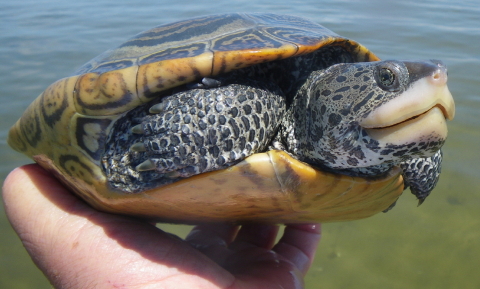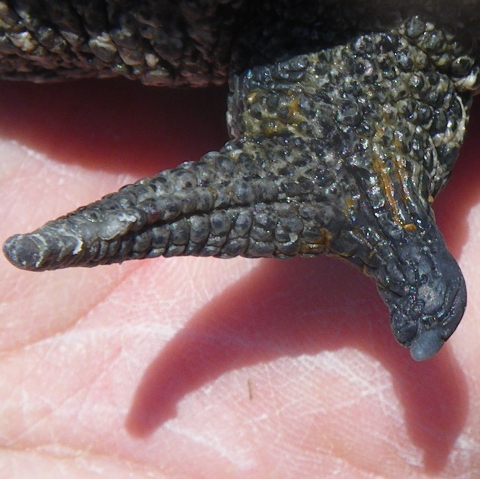
Basking Diamondback Terrapins in Buzzards Bay Estuary
After ten years of intensive research and focused conservation efforts on the SouthCoast of Massachusetts, Turtle Journal savored the image above from Buzzards Bay’s Sippican Harbor. In 2003, this population of terrapins teetered on the brink of extirpation. Thursday afternoon’s display of basking and “dating” turtles sported more diamondback terrapins than we have ever recorded. The rock shown above held five mature females and three mature males. Surrounding rocks held more adults, as well as basking juveniles.

Sue Wieber Nourse Captures Basking Terrapin #329
Sue Wieber Nourse spotted a mature female terrapin basking in the Spartina grass at the water’s edge. She swooped into the spot and hand-captured mature female #329, an important player in restoration of the Buzzards Bay terrapin population.

Female Diamondback Terrapin #329
Terrapin #329 is a very large, mature female terrapin. She tips the scales at 1.5 kilograms and her shell measures 8.5 inches long. From a conservation perspective, these large, mature females are the most important factors in producing new recruits to the population. They lay larger eggs that yield larger, more viable hatchlings; their natal nesting site has proven viable over the years.

Terrapin #329 Nesting at Tabor’s Schaefer Oceanology Lab
Last July 2nd, Sue checked the Tenbrook Beach at Tabor Academy’s Schaefer Oceanology Lab where she previously served as director. Under her leadership, this beach from 2003 through 2005 had yielded the first protected nests in Buzzards Bay as the beginning of the Turtle Journal conservation program.Â

Terrapin #329 Nesting at Schaefer Oceanology Lab, July 2012
On this July 2012 morning, Terrapin #329 was laying her second nest of the year, and Sue was able to harvest the 12 perfect eggs, protect them through incubation and return 12 perfect hatchlings safely to the abutting nursery salt marsh. Such conservation efforts have proven a huge boost to the terrapin population in Buzzards Bay. See Rare Turtle Nests at Schaefer Oceanology Lab.

Female Diamondback Terrapin #701
On Thursday we also recaptured mature female #701. She is even larger than #329, registering 1.7 kilograms and 8.7 inches long. We last saw this lady on 21 May 2010 in the Sippican Harbor mating aggregation.

Female Diamondback Terrapin #601
We first captured mature female #601 on that same day in May 2010, and we have seen her each year since in the Sippican Harbor mating aggregation. On Thursday, this younger female weighed only 1.1 kilograms and measured just 7.4 inches long.

Female Diamondback Terrapin #253
Turtle #253 is a large mature female who we have been tracking since June 2004. She weighs 1.5 kilograms and her carapace measures 8.2 inches long.

Female Diamondback Terrapin #340
We encountered mature female Terrapin #340 again on Thursday. Don Lewis netted her as she cavorted with male Terrapin #41 (see below). You may recall Turtle #340 from last Thursday, May 10th, when Don discovered her pairing with male Terrapin #304. Clearly, she is a popular lady in the Sippican mating aggregation. (See Sippican Harbor Terrapins.)

Female Diamondback Terrapin #41
We found two new terrapins on Thursday whom we had never observed previously. Mature female Terrapin #41 beamed a broad smile during her first interaction with humans.

Male Diamondback Terrapin #40
On the other hand, bashful male Terrapin #40 hid inside his cowl to demonstrate his disdain for this first encounter with researchers. He did, however, sport a dashing Buzzards Bay mustache to compensate for the lack of a smile. Although sexually mature at five years old, Terrapin #40 weighed only 193 grams and measured just 4.3 inches long. Fully mature males achieve only half the linear size and less than a quarter of the mass of mature terrapin females.




































